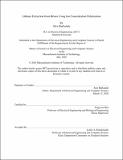| dc.contributor.advisor | Jongyoon Han. | en_US |
| dc.contributor.author | Barksdale, Alex(Alex Christopher) | en_US |
| dc.contributor.other | Massachusetts Institute of Technology. Department of Electrical Engineering and Computer Science. | en_US |
| dc.date.accessioned | 2020-09-15T21:52:45Z | |
| dc.date.available | 2020-09-15T21:52:45Z | |
| dc.date.copyright | 2020 | en_US |
| dc.date.issued | 2020 | en_US |
| dc.identifier.uri | https://hdl.handle.net/1721.1/127334 | |
| dc.description | Thesis: S.M., Massachusetts Institute of Technology, Department of Electrical Engineering and Computer Science, May, 2020 | en_US |
| dc.description | Cataloged from the official PDF of thesis. | en_US |
| dc.description | Includes bibliographical references. | en_US |
| dc.description.abstract | The surge of electric vehicle deployment in response to the global climate crisis has marked tremendous increase in the demand of lithium ion batteries. Lithium brine has gained much attention as a critical primary lithium resource over mineral sources due to cheaper processing and greater abundance. Although lithium brine resources are estimated to account for over 60% of global lithium resources, lithium extraction from brine remains a challenge, as high magnesium concentration in lithium brine severely reduces the purity of precipitated lithium carbonate from brine. Thus, the Mg²⁺:Li⁺ mass ratio is an important metric when considering the economic viability of brine. Because lithium ion batteries require >99.5% purity of lithium carbonate, a technique for selectively reducing the magnesium content in brine while retaining lithium is desired. | en_US |
| dc.description.abstract | Here we present a continuous, scalable ion concentration polarization based technique for reducing the Mg²⁺:Li⁺ ratio of brine. The device utilizes ion concentration polarization, a fundamental phenomenon occurring at the interface of ion exchange membranes, to induce a locally amplified electric field when a potential is applied across the membrane system. The amplified electric field separates ions into streams according to electrophoretic mobility, which can be separately collected and analyzed. In this study, we demonstrate a proof of concept continuous platform to achieve reduction of the Mg²⁺:Li⁺ of brine, over a variety of flow and initial Mg²⁺:Li⁺ compositions of a lab brine. We demonstrate reduction of a 25:1 and 60:1 Mg²⁺:Li⁺ brine to below 10:1 Mg²⁺:Li⁺, which is identified by industrial standards to allow adequate precipitation of high purity lithium carbonate for lithium ion battery production. | en_US |
| dc.description.abstract | We also demonstrate reduction of a 100:1 Mg²⁺:Li⁺ brine to approximately 20:1, despite the short active membrane length used in the experiments. We then provide a techno-economic analysis of the platform, developing a method for comparing the continuous ICP device, with prevalent batch mode membrane technologies in the literature. By accounting for longer effective membrane length, to which energy consumption is well known through experiment and theory to be inversely proportional to, a fair energy consumption comparison can be made. Ultimately, this work demonstrates a potentially powerful tool for continuous lithium extraction from brines, and possibly a generalizable ion separation tool utilizing differences in electrophoretic mobility. | en_US |
| dc.description.statementofresponsibility | by Alex Barksdale. | en_US |
| dc.format.extent | 103 pages | en_US |
| dc.language.iso | eng | en_US |
| dc.publisher | Massachusetts Institute of Technology | en_US |
| dc.rights | MIT theses may be protected by copyright. Please reuse MIT thesis content according to the MIT Libraries Permissions Policy, which is available through the URL provided. | en_US |
| dc.rights.uri | http://dspace.mit.edu/handle/1721.1/7582 | en_US |
| dc.subject | Electrical Engineering and Computer Science. | en_US |
| dc.title | Lithium extraction from brines using ion concentration polarization | en_US |
| dc.type | Thesis | en_US |
| dc.description.degree | S.M. | en_US |
| dc.contributor.department | Massachusetts Institute of Technology. Department of Electrical Engineering and Computer Science | en_US |
| dc.identifier.oclc | 1192462681 | en_US |
| dc.description.collection | S.M. Massachusetts Institute of Technology, Department of Electrical Engineering and Computer Science | en_US |
| dspace.imported | 2020-09-15T21:52:44Z | en_US |
| mit.thesis.degree | Master | en_US |
| mit.thesis.department | EECS | en_US |
